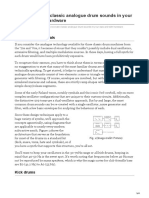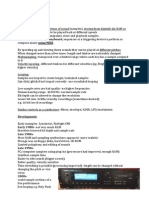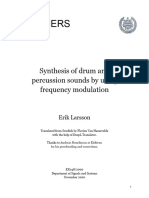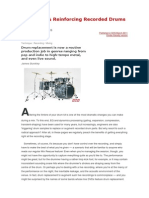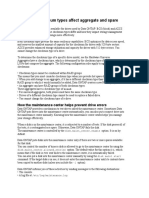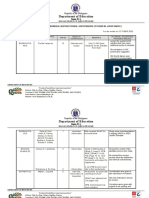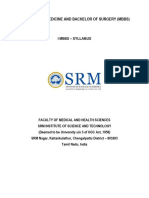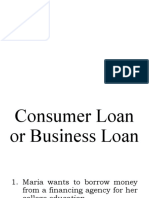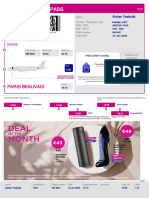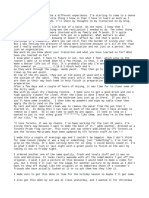LOG IN REGISTER SUBSCRIBE SHOP HELP 0 items Search
SOUND ON SOUND
NEWS FORUM MAGAZINE REVIEWS TECHNIQUES PEOPLE SOUND ADVICE MUSIC BUSINESS
HOME > TECHNIQUES >
E!ective Drum Programming: Part 2
Tips & Techniques
Drum Machines
By Nicholas Rowland Published March 1998
In this article...
Introduction
To Err Is Human
Dynamic Duels
Time, Gentlemen, Time
Timbre Land
Randomisation
Jazz Age: The Examples
In this Series
E!ective Drum Programming: Part 1
E!ective Drum Programming: Part 2
E!ective Drum Programming: Part 3
E!ective Drum Programming: Part 4
SOS Competitions
Yamaha RX-15 drum machine.
Win! TANTRUM AUDIO Angry System
Win! UNIVERSAL AUDIO Apollo x4 Gen 2 &
The debate's been going on for as long as drum machines have been around:
Sphere DLX
can they really sound human? Nicholas Rowland takes jazz drumming as his
test case and tries to find out...
In this month's nail-biting instalment of The Rhythm Method, we're going to investigate various
techniques for making programmed patterns sound more 'human', as well as looking at some
short cuts to generating rhythm tracks with an apparently improvised feel. While the focus of
our attention will be jazz patterns, the subtext is all about injecting the milk of human kindness
into beat boxes in general. So even if you think that jazz is something musicians only do when
they get too old to play music that people actually want to listen to, stay tuned.
On the face of it, jazz drum programming appears to be a contradiction in terms. Jazz music is
supposed to be all about the spontaneous expression of heart and soul, while drum machines
and sequencers are soulless machines, the very opposites of spontaneity, creativity and having
a good laugh down the boozer after the gig. That was certainly true 10 years ago, when drum
machines simply didn't have the technical facilities to compete with humans on a jazz tip. First,
the sounds themselves were often not realistic enough to be appropriate for jazz (though, to be
fair, this was more an attitude of mind than a valid technical issue). Second, and more
importantly, early drum machines just didn't o!er the necessary control over dynamics and
quantisation which are necessary if you want to emulate the subtle nuances of a live drummer
in full flow.
...thanks to cut and paste, you can quickly generate drum tracks which have an
apparently improvised feel.
These days, there are no excuses. Armed with the most basic GM module/workstation and the
humblest of computer sequencers, you can produce jazz patterns that not only sound
convincing, but swing with the best of them. The only real limit to your creativity is your time.
Sequencers and drum machines only put out what you put in. If you want to create a rhythm
track based around the idea that each bar is di!erent from the next, then you'll have to be
https://www.soundonsound.com/techniques/effective-drum-programming-part-2 28/06/25, 19 40
Página 1 de 7
:
� prepared to program every single variation yourself. From my own experience, I know it can Readers' Ads
take many hours to recreate the kind of spontaneous-sounding jazz track that any drummer
worth their salt could lay down in a single take. Be prepared. VIEW ALL ADS CREATE FREE AD
To Err Is Human On the same subject
One question which is perhaps worth spending a few lines considering is what exactly 2025 SOS Awards: THE RESULTS
February 2025
di!erentiates a rhythm played by a human from one created by a machine. Setting aside the
Ableton Move
issue of sounds and ambience for the moment, can most people actually tell the di!erence
November 2024
between a recording featuring a real drummer and one driven by a beat box? It was probably
Hardware Drum Machines
easier to distinguish in the early days, when a combination of lazy programming and a lack of November 2024
onboard memory meant that drum machines gave themselves away by undue repetition. The Elektron Digitakt II
lack of control over dynamics also meant that drum machines really did sound like November 2024
metronomes — not so much because of the regularity of timing, but because of the total Drum Beat Construction - Part 2 | SOS Podcast
consistency of the sounds. What makes music 'human', on the other hand, is the minor June 2024
inconsistencies in the playing, in terms of timing, dynamics and the variations inherent in
acoustic instruments. There's also this ephemeral notion of 'interpretation' — which can, From the same manufacturer
perhaps, be defined as an ability to creatively bend the rules to enhance the emotional
pleasure of the music. Or to put it another way, if it ain't got that swing, it don't mean a thing. Yamaha NS-10M Studio Monitors | SOS Podcast
June 2025
Q. Can I mimic NS-10s and Auratones with EQ?
Dynamic Duels March 2025
Yamaha FGDP-50
As I mentioned last month, dynamics (the relative MIDI velocity levels of the di!erent February 2025
instruments) are crucial to creating a sense of movement within any style of drum pattern. Workstation Synthesizers
Creating convincing jazz patterns requires even more attention to detail in this matter. May 2024
Obviously, the easiest way to achieve a human feel is simply to program your rhythms in real Why I Love... Old Keyboard Mixers
February 2024
time, using a velocity-sensitive MIDI keyboard, drum pads or drum machine buttons. I'd
recommend this as your standard approach with cymbal parts, which often provide the fluidity
of movement within a rhythm. (In jazz, it's the ride cymbal which is the dominant time-keeping SIGN UP TO
instrument, as opposed to the hi-hats). Most sequencers o!er a mixture of pattern-based and SOS NEWSLETTERS
linear recording, so it's easy enough to build up a basic track from a series of step-time created
patterns, then go back and record a new 'live' cymbal line over the entire track. Try also setting
the quantise function to a very fine resolution, or turning it o! altogether. You can normally go
back and correct any really wayward beats after the event, using the over-quantise function.
Time, Gentlemen, Time
What originally really used to get up people's noses about drum machines was the fact that
they kept 'inhumanly' strict tempo — a charge which is still levelled at sequenced music per se.
There are two issues here. One is about variations in tempo across the whole track — in other
words, the fact that people naturally speed up and slow down during di!erent bits of a song.
There's no reason why sequenced music shouldn't also speed up and slow down, and thanks to
the wonder of sequencer tempo maps it's very easy to build this kind of variation into a song. In
fact, whatever the style of music, one trick is to nudge the tempo up by a couple of beats when
you hit the chorus or playout, and take it down a few notches in the bridge from the
introduction to the first verse, or the bridge from the middle eight to the next verse, and so on.
Latest SOS Videos
The second issue concerns the minuscule variations in timing that occur within a pattern. Here
we're touching on a human foible known in drumming circles as playing behind or in front of
the beat. The fact is that the majority of human drummers (and, for that matter, most other
musicians) rarely hit the notes right on the button. Some will have a natural inclination to play
slightly early, others will play slightly late; some can go back and forth as the music demands.
Playing behind the beat will drag the song back and make the track sound slightly slower than it
actually is. You notice this in a lot of slow blues and funk numbers, where often the whole band
hits everything slightly late. Playing ahead of the beat gives the song real urgency, making it
sound faster even though the tempo hasn't actually changed. Again, this is easily replicated on
most sequencers (and some drum machines), which allow you to shift patterns or entire drum
Mixing Dune: Part Two OST | Alan Meyerson Webinar
tracks by a specified number of MIDI ticks. It's worth experimenting with this function,
particularly on the snare when you've got a regular beat on the two and the four. But don't
overdo it, or your drummer will just sound out of time.
Some sequencers and drum machines take this a stage further, with intelligent quantise
functions which alter the MIDI velocity of certain beats, while also shifting the timing of certain
beats by tiny amounts. But whereas early applications of this function imposed the changes
randomly, it's now based on more careful analysis of the rhythmic pulse of particular styles of
music. Personally, I think these functions work best when they're applied sparingly — for
example, to a fill or particular drum phrase rather than across the entire track. (See the
examples box for further discussion of this.) Otherwise the drumming just sounds wrong rather
than 'human'. Trinnov NOVA User Report - PresentDayProduction
Timbre Land
As most people are aware, an acoustic drum doesn't just get louder when it's struck harder, it
also changes timbre, rising in pitch and exhibiting more pitch-bend. Cymbals will also change
https://www.soundonsound.com/techniques/effective-drum-programming-part-2 28/06/25, 19 40
Página 2 de 7
:
� timbre according to where they are struck on their surface, and also how rapidly they are
played. Some drum machines and sound modules simulate this through multi-sampled voices
which will change according to MIDI velocity. If a sampler is the source of your drum voices, you
can also easily set up velocity-sensitive cross-fades between di!erent pitches of the same
sound or, indeed, di!erent sounds.
A similar e!ect can be achieved with more humble equipment. For example, the standard GM
kit o!ers a choice of two ride cymbals, plus a more 'clangy'-sounding ride 'bell'. As a matter of
course, I would use at least two of these sounds within a jazz ride pattern, if not all three. It
really does make a di!erence. Similarly, when programming two bass drum notes in quick The Secrets Of Pink Floyd’s Quadraphonic PA
succession, try using a softer, more rounded one for the first beat and a sharper, heavier
sound for the second.
Randomisation
So far, so good. But while technology may be on our side in terms of making individual patterns
sound more human, I appreciate that not everyone has the time and patience to laboriously
trawl through a drum track beat by beat, instrument by instrument, tinkering about with
individual velocities, timing values and so on. However, thanks to the power of cut and paste,
you can quickly generate drum tracks which have an apparently improvised feel.
Dynamics are crucial to creating a sense of movement within any drum pattern.
The process starts with the creation of a 1- or 2-bar 'master' pattern. With a jazz track it might
be the archetypal jazz cymbal rhythm, underpinned by a basic bass and snare figure. This is
then copied to several pattern locations — an easy enough job whether you're using a
stand-alone drum machine or a computer-based sequencer. You then call up one of these
copies and start deleting, adding or moving a couple of cymbal beats here, a couple of snares
or basses there. Maybe just delete every fifth cymbal note — whatever. The trick is not to think
too hard about what you're doing, and for this reason I often work in step time, because then
it's hard to second-guess the end result. What you should end up with is a family of 1-bar
patterns, all based around the master rhythm, yet each one slightly di!erent. When chaining
these together to form the song, simply assemble them in a random order. Hence the first
verse might consist of patterns 1/2/3/4, but the second would be 2/4/2/3, and so on. Again,
don't try to second-guess the result. When played end to end, the finished rhythm track might
sound a bit i!y, but once you've got the rest of the instruments in place the result should
sound more coherent.
With a sequencer, applying this technique is even easier. For example, in the edit page of a
program like Cubase you can easily sub-divide your master and variation patterns into smaller
sections — half-bars, or even quarter-bars, for instance, and then use these smaller building
blocks to build up the complete drum track.
Once the other parts are in place, it's worth going back to the drum edit page and tweaking the
patterns to better fit the structure of the track. For example, there might be places where the
insertion of a crash cymbal would provide an accent or mark the division of a bar.
Et voila! What you now have is a rhythm track with a large element of unpredictability about it
— almost as good as a having a machine with its own mind!
Jazz Age: The Examples
Your starter for 10 is a cluster of four jazz patterns based around the archetypal jazz
cymbal pattern. In rhythmic terms there's nothing to blow your socks o!. What I'm more
interested in here is illustrating some of the techniques explained in the main article.
Before we get into that, though, some basic house rules: whereas rock and pop rhythms
are based on even-length notes, jazz rhythms are divided into uneven sections based on
combinations of quavers, dotted quavers and semi-quavers.
The archetypal jazz hi-hat/cymbal rhythm
(you'll know it when you hear it, honest) is
based on a quaver/dotted quaver/semi-quaver
combination. However, this is played with a
triplet feel, so in programming terms it's
easiest to program in triplets. So the patterns
this month were all created using a quantise
value of 8th-note triplets (that is, 12 steps to
the bar.) You'll see that a few examples actually use 16th-note triplets, but for the sake of
making the grids easy to understand, I've kept the grids quantised at 12 steps to the bar.
In Part 1 we had three dynamic levels, but this month I've used four. And instead of
giving them absolute MIDI velocity values, I've suggested a range of dynamic levels to
play with. Ideally, you would tweak each beat/instrument, so that no consecutive values
are the same. Finally, while this month's examples are all based on jazz patterns, the
general points covered in the main body of the text are equally applicable to any style of
music where a human feel is required.
https://www.soundonsound.com/techniques/effective-drum-programming-part-2 28/06/25, 19 40
Página 3 de 7
:
� JAZZ PATTERN A
Jazz Pattern A.
This is the archetypal (some might say cliché) jazz rhythm, played using the ride cymbal.
Note, though, that even with a simple pattern such as this, we're using the ride and ride
bell sounds to add a little extra interest to the rhythm.
JAZZ PATTERN B
Jazz Pattern B.
With more blobs on the grid you can see that this is a more intricate version of pattern A.
Again we're mixing the ride bell and ride cymbals to give more interest at the top end.
I've also doubled up the tambourine with the pedal hi-hat to add emphasis to the second
and fourth beats in each bar.
JAZZ PATTERN C
Jazz Pattern C.
The snare fill towards the end of the second bar uses a mix of two snare sounds to
simulate the changing timbre of an acoustic drum. The 'double diamond' (brush snare,
fourth beat, second bar) is a flam, when two notes are played close together.
JAZZ PATTERN D
Jazz Pattern D.
This example mixes sounds again — bringing in the metallic sounds of a timbale over the
top of the brush snare during a short roll. The psychedelic wedges are supposed to
https://www.soundonsound.com/techniques/effective-drum-programming-part-2 28/06/25, 19 40
Página 4 de 7
:
� indicate the fact that one gets louder and the other gets quieter — but I guess you'd
probably worked that out for yourself. Timbale sounds are often quite strident, so you
might have to play around with the relative volumes of the snare and timbale to get the
most pleasing e!ect.
GROOVE-QUANTISED FILL
Groove Quantised Fill.
This is a simple jazz fill pattern which has been part-doctored using a Cubase groove
quantise, although only the bit contained in the white box. The results are shown more
clearly in the enlarged section. The result is a lazy, lumpy snare fill which sounds very
human indeed! I would probably apply this quantise to any other instruments which
were playing at this time, so that the whole 'band' sounds locked in together, even
though they're all 'out of time'. Rather than applying these quantise treatments
wholesale across a song, I tend to use di!erent treatments in di!erent parts of the song.
There are times when you want things to sound tight and absolutely locked into the
groove, other times when you want to 'push' a chorus, or 'pull back' a verse. This may
sound corny, but think of the di!erent character of each part of a song, then look at how
you might enhance them through playing about with the micro-timing of beats.
You can also try a reverse approach. A lot of people will quantise the rhythm track to
death while being happy to input the rest of the instruments in real time. What you can
consider is copying instrumental tracks to the drum tracks, then using the note-ons of
the melodic parts as the basis for quantising the drums.
GHOSTED NOTES
Ghosted Notes Example.
If you watch a jazz drummer playing, you'll notice a lot of tapping away at the snare drum
in between the main beats or accents. These are often known as ghost notes and, while
you often can't hear them when a band is in full flight, they add a characteristic
background wash to a recording or live performance. The purists out there might
consider even taking all the attack o! the ghosted sound and then feeding it through a
short reverb back into the main drum mix. This also goes some way towards simulating
the way that the snare will vibrate whenever other drums in an acoustic kit are struck.
JAZZ IMPRO 1, 2 & 3
https://www.soundonsound.com/techniques/effective-drum-programming-part-2 28/06/25, 19 40
Página 5 de 7
:
� Jazz Impro 1.
Jazz Impro 2 example.
You've probably already got the idea from the main body of the text, but here's a couple
of patterns which have been chopped up and reassembled.
The toms in Jazz Impro 1, especially in Section 1, give the pattern a strong theme, so
when putting the track together I've used this as the first bar in each four-bar section.
Previous article Next article
New forum posts Active topics Recently active forums
Re: Trolley/cart for PA? AI Fiddling Recording: Gear + Techniques
Dave71 Mixing | Mastering | Post Production
Is it ok to feed a TC Helicon VoiceLive Play with the phones output of a Roland Juno DS-88?
Live Sound | Performance 28 Jun 2025, 18:59 New Products + Industry News
Music Business
Re: Distorted telephone conversation Considering moving from PC to Mac. Low latency performance?
Mac Music
The Red Bladder
Minimum to start recording Windows Music
Mixing | Mastering | Post Production 28 Jun 2025, 18:45
Apps | Other Computers/OS
Video: First gig back after my brother was taken seriously ill last year
Re: Rcf 932a - worthy upgrade? Guitar Technology
Dave71 Zero-G Summer Sale 2025 | Up to 70% o! + FREE add-ons Keyboards + Synthesizers
Live Sound | Performance 28 Jun 2025, 18:39
DIY Electronics + Studio Design
Advertising Revenue from Israel
Re: Minimum to start recording Live Sound | Performance
https://www.soundonsound.com/techniques/effective-drum-programming-part-2 28/06/25, 19 40
Página 6 de 7
:
� S2 Farfisa emergency Music Theory | Songwriting | Composition
Recording: Gear + Techniques 28 Jun 2025, 18:19
User Reviews
Sonuscore Sale - Up To 70& O! Virtual Instruments
Re: Considering moving from PC to Mac. Low latency performance? Remote Collaboration
The Elf Cubase 14 problem - again :-(
Self-Promotion
Mac Music 28 Jun 2025, 18:08 Feedback
SOS Support Forum
Contact Us Cookie Policy Help Privacy Policy Terms of Use
All contents copyright © SOS Publications Group and/or its licensors, 1985-2025. All rights reserved.
The contents of this article are subject to worldwide copyright protection and reproduction in whole or part, whether mechanical or electronic, is expressly forbidden without the prior
written consent of the Publishers. Great care has been taken to ensure accuracy in the preparation of this article but neither Sound On Sound Limited nor the publishers can be held
responsible for its contents. The views expressed are those of the contributors and not necessarily those of the publishers.
Web site designed & maintained by PB Associates & SOS
https://www.soundonsound.com/techniques/effective-drum-programming-part-2 28/06/25, 19 40
Página 7 de 7
:
























